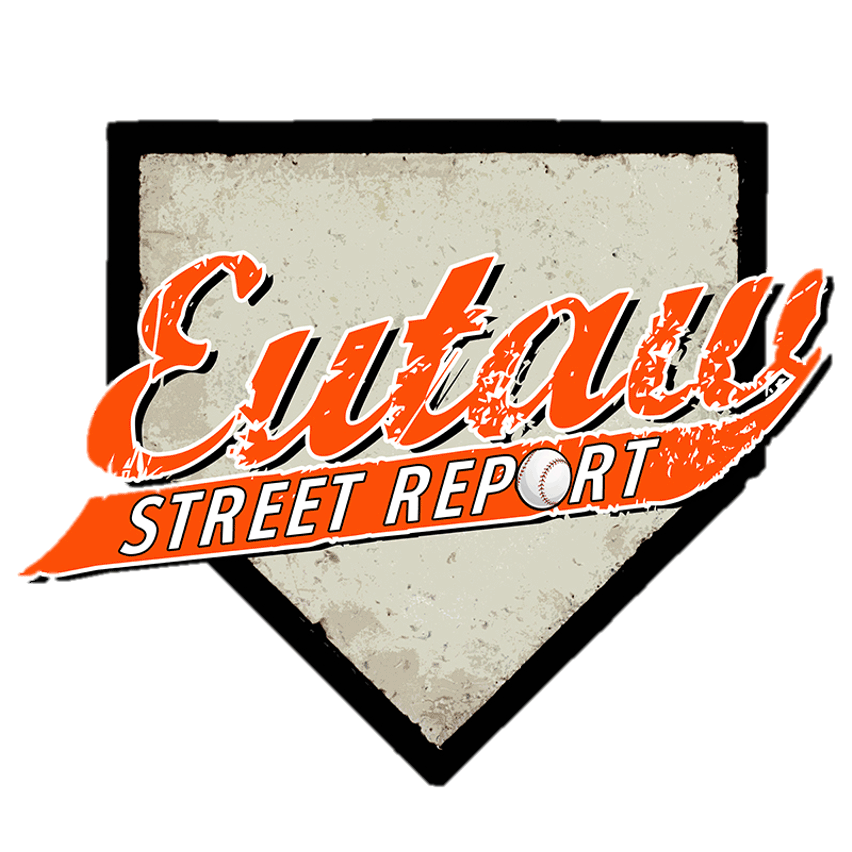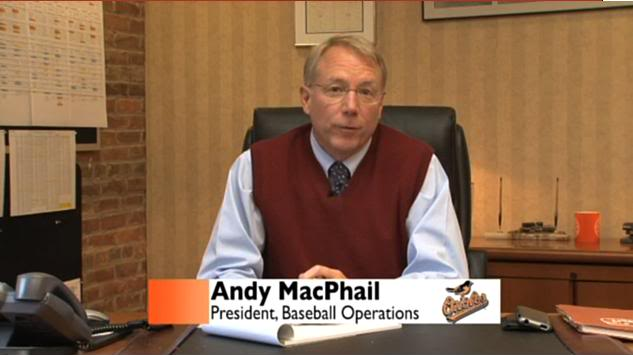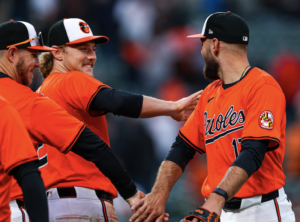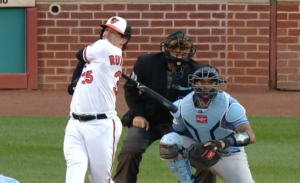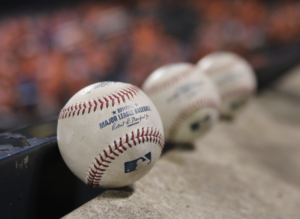Perhaps it was the Duquette saga this offseason that got people waxing nostalgic for Andy MacPhail, but I had to respond to my fellow writer Geno Rodriguez’s piece on the former President of Baseball Operations.
Geno echoed a sentiment held by many O’s fans, that MacPhail had the most influence in the Orioles’ turnaround, and that he “resurrected” the franchise.
However, MacPhail actually held the Orioles back from reaching success sooner with the moves he made and the moves he should have made, but didn’t.
Let’s start with the very first major move of his tenure – the Erik Bedard trade.
The Bedard Trade Revisited
The Erik Bedard trade is looked at by many as being the hallmark move of the MacPhail era. The Orioles were able to acquire Adam Jones and Chris Tillman from Seattle, two major pieces of the current Orioles’ core roster.
The Orioles also acquired George “Flat Breezy” Sherrill, who closed for the Orioles for a season and a half before being traded to the Dodgers for 3B Josh Bell and RHP Steve Johnson.
Bell was a disappointment due to his poor attitude and performance and is now playing in Korea, while Johnson has bounced back and forth between the majors and minors.
The other two parts of that deal were pitchers Kam Mickolio, who was dealt in a trade along with David Hernandez to the Diamondbacks for Mark Reynolds, and Tony Butler, who was injured and never pitched above A ball.
So a five-for-one deal seems great on the surface but I’ll throw out a name out there that trumps the whole deal: Clayton Kershaw.
The Orioles very likely could have had Clayton Kershaw from the Dodgers for Bedard, as his name was discussed, but MacPhail wanted multiple players coming back in any Bedard trade to minimize the risk.
Comparing him to Jones and Tillman and Sherrill, Kershaw’s value is enough by himself to win the deal without anybody else. Jones, Tillman and Sherrill have combined for 30.8 fWAR as Orioles while Kershaw has a total value of 35.7 fWAR.
If Kershaw was at the top of this rotation right now instead of Tillman, you also can bet the Orioles would be favored to win the AL East and be a top contender to represent the AL in the World Series.
So while the Bedard deal was a huge win, it could have been even bigger, had it not been for MacPhail’s need to get multiple players as a return.
Now let’s look at his record in free agency.
Free Agency
Of course you have to bring up the name Mark Teixeira, and in retrospect, the Orioles’ reported offer of 7/150 would have been a better contract than what the Yankees gave out. I’ll admit I was wrong for wanting the Orioles to give him more, as that contract would be an albatross based on Tex’s performance and health. MacPhail’s judgment ultimately turned out to be correct there.
The player that got away is actually Matt Holliday. Holliday was coming off a season in 2009 where he’d been traded to St. Louis at the deadline, helped the Cardinals to the playoffs and yet the Cardinals barely made a move to re-sign him all that winter, and they were the only known suitor. Meanwhile the Orioles had a connection to Holliday through Brian Roberts, who was lobbying Holliday to come to Baltimore. The problem was that MacPhail and the Orioles had little interest and allowed Holliday to re-sign with the Cardinals for a team friendly 7/120 contract.
Holliday has put up over 23 fWAR during the past five years of the deal, easily making him worth the cost of the contract. He could have helped the Orioles win from 2011 to 2014.
Instead, here’s a table of players MacPhail signed since they had the opportunity to ink Holliday along with their contract and value for their tenure with the Orioles.
So basically MacPhail committed over $42 million to get replacement level value with five players over two seasons, when he could have spent under $40 million and got 11.0 fWAR from Matt Holliday alone for the first two years of his deal.
MacPhail always thought the long term deals for premium talent were too risky and thought he could make up that value with multiple players with short term contracts. Those short term contracts, however, turned out to be an extremely poor allocation of resources.
If the Orioles wanted 0.0 fWAR over those five players, they could have played their minor leaguers and saved the money.
Out of all the failures in the MacPhail era, free agency was his biggest and it hurt the Orioles the most.
Roster Management
If free agency was MacPhail’s biggest weakness, his roster management was a close second.
The best case to illustrate this is during the 2008 season, when the Orioles had four players on the 25 man roster to play shortstop after Miguel Tejada was traded in the offseason. Remember Freddie Bynum, Alex Cintron, Brandon Fahey and Luis Hernandez? Two of those four would comprise the Orioles’ bench in April through June while a third would start at shortstop.
Dave Trembley didn’t exactly have a great option off the bench picking one of those no-hit guys in the late innings to pinch hit.
None of those four players were able to establish themselves as an adequate option and it was clear by the end of April that a solution needed to be found outside the organization. It wasn’t until July 19th however when MacPhail finally acted and acquired Juan Castro from the Rockies to be the permanent starter – but he wasn’t much better, offensively or defensively.
To keep all those no-hit shortstops, MacPhail also optioned Scott Moore, a player who could provide power and on-base ability at third base and first base and had proven himself in Spring Training and in the cup of coffee he got after being traded as part of a deal that sent Steve Trachsel to the Cubs. The Orioles were clearly rebuilding, yet MacPhail couldn’t find room for Moore.
The fact that Moore, at 24 years old, as a former first round pick, only got nine plate appearances in four games that season is a travesty. The Orioles might have discovered another Casey Blake-type of player had MacPhail actually given him a legitimate shot.
The 2008 season also featured the use of the 13-pitcher roster where the 13th pitcher was hardly ever used. The 13 pitchers of course was the solution to starting multiple pitchers from the minors that weren’t ready and journeyman that were basically throwing batting practice and had many short outings. Trembley had his “doghouse,” however and that’s how he chose to use that roster spot, with Greg Aquino being in that spot the longest.
The 13-pitcher roster is still used from time to time by Duquette and Buck Showalter, but it’s typically only temporary, usually after a long extra-inning game or doubleheader to get a fresh arm on the roster.
It should have never been used as a solution for having inadequate starting pitching.
The Draft
Many O’s fans want to give credit to MacPhail for the signing of Matt Wieters, but actually the credit should first go to the late Mike Flanagan and also Jim Duquette.
Flanagan scouted Wieters personally at Georgia Tech, and Duquette had the relationship with Scott Boras to lay out the groundwork to make sure they could sign him. The Orioles then drafted Wieters with the 5th pick in the 2007 Draft.
The stage was set. It wouldn’t be an easy negotiation to get Wieters in an Orioles uniform, but they were confident they would get it done.
Then along came MacPhail, who had this to say about the Wieters negotiations as the deadline drew near:
“You like to get players signed,” MacPhail said. “The only difference this year is rather than getting compensation that would be pick 42 or whatever, now in the event you don’t sign [a first-rounder] this year, you get like compensation. So it is more deferring a pick than losing a pick. But that doesn’t alter the fact that you’d like to get signed those that you draft.”
MacPhail was actually willing to let Wieters go and pick again the following year, but thankfully Peter Angelos got involved literally at the 11th hour as Orioles’ scouting director Joe Jordan described:
“They got the deal done,” said an elated Orioles scouting director Joe Jordan. “You can tell the city of Baltimore that the old evil owner stepped up and took care of things tonight. We had to fight to the end.”
Wieters was signed in spite of Andy MacPhail, not because of him, and it is Flanagan, Duquette and ultimately Peter Angelos that deserve the credit.
MacPhail was able to oversee four Orioles drafts and this is how the Orioles drafted in the first round:
2008: Brian Matusz. Notable passes – Buster Posey, Jason Castro
2009: Matt Hobgood. Notable passes – Mike Trout, Mike Minor, Shelby Miller
2010: Manny Machado. Notable passes – Chris Sale, Matt Harvey
2011: Dylan Bundy. Notable passes – Archie Bradley, Javier Baez, George Springer, Jose Fernandez, Sonny Gray
2008 and 2009 are likely the worst misses, with Matusz now an expensive LOOGY and Hobgood still yet to pitch above A ball. 2010 was the best pick in Machado though Sale and Harvey are dominant starting pitchers. In 2011 Bundy had the hype, but Jose Fernandez, Sonny Gray and Archie Bradley have turned out to be better prospects with Fernandez and Gray dominating in the majors already. The Orioles would also love to have Springer or Baez in their lineup right now I’m sure. The jury is still out on Bundy, but he’s lost value and likely no longer profiles as a dominant top of the rotation starter, though he could be a solid #3 or #4 in time if not a dominant bullpen arm.
It’s no surprise that three out of the four first round picks in the draft were pitchers under MacPhail, who favored stockpiling arms over bats with his – “grow the arms, buy the bats” philosophy. However, the arms he drafted were not the best available by any means, and the only time the Orioles hit on a player, it was a position player.
Managers
MacPhail inherited Dave Trembley when he took over the team in June 2007 and although it was pretty obvious that Trembley was over his head as interim manager, MacPhail gave him an extension for the 2008 season with a team option for 2009 on August 21, 2007 instead of searching for a new manager after the season.
That date should be familiar to Orioles fans, because it was the first appearance at Camden Yards of first-round pick Matt Wieters. It was also of course, the day of the worst loss in modern baseball history, when the Texas Rangers humiliated the Orioles, 30-3 in Game 1 of a doubleheader.
If that wasn’t a perfect omen of the team’s future performance under Dave Trembley, I’m not sure what else would have been.
Flash forward to the 2008 season. The Orioles were languishing in the cellar of the AL East and MacPhail once again could have gone in a new direction, but again decided to continue Trembley’s tenure as Orioles manager, picking up his 2009 option and adding an option for 2010.
Here’s what he had to say about the decision:
“There is a lot required of a Major League manager, whether it be the tactical aspects of the game, communication with the players, communicating with the fans through the media, dealing with the front office,” he said. “I think David has excelled in those areas, particularly the one that’s most important to me and the fans — that the players play hard, play with energy and effort and enthusiasm. I think we all feel like … before we started to have injury issues which demonstrated our lack of depth, particularly in this division, we feel like we got our money’s worth in that area. That’s important to me.”
Wins apparently weren’t.
MacPhail would also go on to pick up Trembley’s option for 2010, sticking with him for a third time in spite of another fifth-place finish. He finally fired Trembley in June of that season after the Orioles started out with a 15-39 record.
Buck Showalter was a candidate to replace Trembley, but MacPhail was said to have favored Eric Wedge over him while Angelos preferred Showalter. As we know Showalter was ultimately – thankfully – the choice.
Imagine if Eric Wedge, not Buck Showalter had become Orioles manager in 2010. Do you think things might be a little different?
Once again, we have Angelos to thank, not MacPhail.
What MacPhail does get credit for is retaining Trembley three times, when it was clear a change in the manager was needed each time. No other Orioles manager in club history got as many chances with a record like Trembley had (187-283).
Once the change was finally made to Showalter, the Orioles players responded immediately with a 34-23 record to finish the 2010 season, though they did regress in 2011 once again (69-93) before having three consecutive winning seasons in a row from 2012-2014.
It makes you wonder how much success the Orioles would have already had before 2012 if they had hired somebody like Showalter after 2007, 2008 or 2009, instead of retaining Trembley.
Front Office Personnel
Sports journalist George Castle wrote a book titled Sweet Lou and the Cubs: A Year Inside the Dugout. In that book he talked about MacPhail’s front office structure with the Cubs and had this quote from MacPhail about his philosophy for the number of staff he employed:
“I would rather be one man too short, than one man too heavy”
He ran things pretty lean with the Orioles as well, but somehow found a way to include his nephew, Lee MacPhail IV in the organization, along with former Reds GM Wayne Krivsky.
Lee was put in charge of professional scouting. Judging by how terrible the Orioles scouting was in terms of identifying which free agents to sign(shown above), as well as their advance scouting for the major league team, his nephew benefited more than the Orioles from his uncle’s nepotism.
As for Krivsky, it wasn’t clear exactly what his role was as MacPhail’s “Special Assistant,” but he came on board after Jim Duquette left and only stayed one year. MacPhail credited him with the Ramon Hernandez trade to his former club which netted Ryan Freel, who was damaged goods, along with minor leaguers Justin Turner and Brandon Waring. Turner actually has stuck around in the majors and just had a 3.2 fWAR season with the Dodgers, but Hernandez was the best player in that trade and the Orioles dumped him for little value. The Krivsky hire also seemed to benefit him more than it did the Orioles.
MacPhail also left the Stockstill brothers, John and Dave, in crucial roles, with the former being assigned to international scouting and the latter the development in the minor league system, before the two swapped roles in 2010.
John was more of an asset than his brother Dave, to the point where he was put in charge of the more important player development and Dave was re-assigned to international scouting, which was an afterthought for the organization.
Neither Stockstill made any drastic improvements to the scouting or development side, although the Orioles did finally sign their first Japanese player in 2009, Koji Uehara. However, they mistakenly slotted him in the rotation instead of his eventual role in the bullpen, where he would dominate for years.
The one bright spot of the front office was the hiring of Matt Klentak, who was a fresh young mind from the Rockies organization. After MacPhail departed, Klentak was instrumental in running the Orioles’ front office with Buck Showalter and in acquiring Darren O’Day off waivers from the Rangers.
“Grow the Arms, Buy the Bats”
MacPhail was known for his catch phrases just as much as his sweater vests, but the one phrase that was his mantra was “grow the arms, buy the bats.”
MacPhail did not believe in signing good free agent pitchers to long term contracts, not when “the Cavalry” (the nickname for the ill-fated group of Brian Matusz, Chris Tillman and Jake Arrieta) were in the minors, just waiting to inherit their rightful place in the starting rotation and lead the Orioles to the promised land.
The problem was however, MacPhail acquired no depth around the cavalry other than the likes of journeymen like Steve Trachsel (twice) and Kevin Millwood, because he didn’t want to block the Orioles younger pitchers. It was sink or swim once those journeymen faltered, and the Orioles’ young starters sunk.
Matusz, Tillman and Arrieta were all on the Baltimore-to-Norfolk shuttle early in their major league careers, unable to stick in the Orioles rotation. Instead, the Orioles started the likes of Brian Burres, Chris Waters, Rich Hill, Adam Eaton and Chris Jakubauskus in their place – with predictable results.
As for “buying the bats”, the discussion of free agents above indicates how that worked out. The Orioles, due to their unbalanced focus on pitching, had very little quality position depth, and thus had nobody to step up – other than more minor league journeymen – when the free agents faltered. So many of those free agents played their last or second to last season in Baltimore because the Orioles would let them due to a lack of a suitable alternative.
To tell you how bad the Orioles’ offense was in 2010 for example, Ty Wigginton was the Orioles’ All-Star representative that season as a reserve. Their DH, Luke Scott, was actually their best player (.902 OPS) but nobody other than Nick Markakis (.805) had an OPS close to .800.
The “grow the arms, buy the bats” was a great idea in theory, but the execution of it was a complete failure.
Brian Roberts and Nick Markakis extensions
Besides the Bedard and Tejada trades, the biggest moves that MacPhail made were his contract extensions with Brian Roberts and Nick Markakis
Roberts was one of the Orioles’ most popular players along with Markakis, and Roberts was due to be a free agent after the 2009 season. MacPhail tried to work out a deal with the Cubs in the offseason before the 2008 season, after he dealt Bedard, but couldn’t pull the trigger.
Roberts would turn 31 years old during his last arbitration year with the Orioles, but MacPhail signed him to a four-year, $40 million contract to ensure he’d stay an Oriole for his career. It sounded great at the time for most nostalgic Orioles fans, to keep a beloved, homegrown Oriole in the uniform for his career, but it would turn out to be a terrible move.
In 2010, the first year of the extension, Roberts would only appear in 59 games due to various injuries and his OPS dropped from .807 in 2009 to only .745. It was in the last part of the season, after he hit himself in the helmet with a bat in a moment of frustration, that his career would be forever changed. Roberts gave himself a concussion with that incident, and it would haunt him and the Orioles for the rest of his time in an Orioles uniform.
In all Roberts played in only 283 games in the four years of that deal due to his injuries, and amassed a value of 1.0 fWAR for the $40 million the Orioles paid out to him. Now part of that was likely picked up by insurance due to his injuries, but the point remains that it was a terrible deal.
Nick Markakis’ extension also occurred in the offseason before the 2008 season, and he signed for six years and $66.1 million. Unlike Roberts though, Markakis stayed on the field for the most part during that contract, but his production also took a drastic hit. In the first year of his deal Markakis’ value went from 6.1 fWAR in 2008 to 2.0 fWAR in 2009. Markakis would never again see a season value of above 3.0 fWAR with the Orioles and had a total value of 10.2 fWAR during that contract.
Final thoughts
If you add up the money spent on Roberts, Markakis and the major free agents listed above from 2009-2011, MacPhail committed to a total of $148.35 million for only 11.2 fWAR. If you take away Markakis, then it is $82.25 million for 1.0 fWAR.
It doesn’t get much more terrible than that in terms of resource allocation, which is why it is really surprising to me that people still think of MacPhail as being a successful GM in Baltimore.
His record with the Orioles was 307-433 for a winning percentage of .414, which is the lowest in club history for a GM with his tenure. Syd Thrift was likely the Orioles’ worst GM, but MacPhail brought the Orioles to their lowest period of success in team history.
Sure MacPhail made some excellent trades in acquiring Jones and Tillman and later J.J. Hardy and Chris Davis, but he stuck with a terrible choice for manager, was terrible at roster management, terrible at resource allocation, and did next to nothing to improve major and minor league scouting as well as player development in the Orioles’ minor league system.
MacPhail also had autonomy from Angelos and the title of President of Baseball Operations, a gift many past GMs would have loved to have, and he did not take advantage of it at all. Instead he was stubborn, holding to his mantra of “grow the arms, buy the bats” in spite of the consistent failure in execution, and held the club back unnecessarily, waiting for internal development that would never occur. As a result, the Orioles languished in basement of the AL East and continued to be a doormat for the rest of the teams in that division until Buck Showalter arrived.
I can’t give a GM like that any credit for “resurrecting” a franchise when at best he treaded water, and at worst almost drowned.
